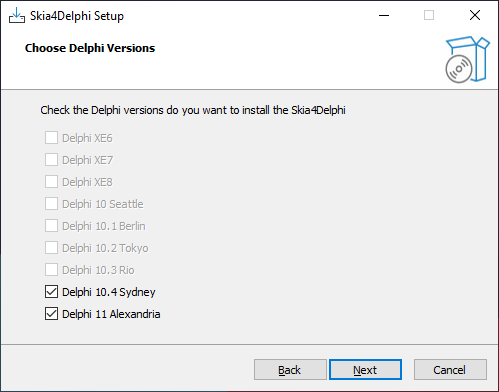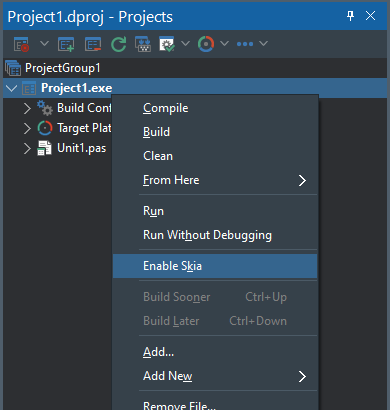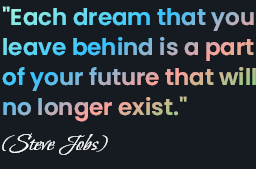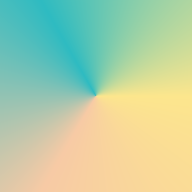Skia4Delphi is a cross-platform 2D graphics API for Delphi based on Google's Skia Graphics Library (skia.org).
Google's Skia Graphics Library serves as the graphics engine for Google Chrome and Chrome OS, Android, Flutter, Xamarin, Mozilla Firefox and Firefox OS, and many other products.
Skia is a great open source library for drawing 2D Text, Geometries, Images, focused on accurate, high quality and high performance rendering, which provides common APIs that work across a variety of hardware and software platforms.
- Installation
- Enabling your project
- Documentation
- Basic Usage
- Text RTL
- Custom Fonts
- Paragraph
- WebP
- Controls
- TBitmap integration
- Debug
- Limitations
- Version
- Build
There are two recommended ways to install the library:
-
Install Skia4Delphi via GetIt (RAD Studio > Tools > GetIt Package Manager...)
-
Or just download and run our setup in releases page
But, if you want, you can also do the manual installation (although it's a lot of work). See the full documentation of installation.
After install the Skia4Delphi, you need to enable your project to be able to run with the skia library. In your IDE, just right click in your application project and "Enable Skia".
Skipping this step, your application startup will get a "runtime error".
Note: You don't need to do this step in package projects that use our units. This step is exclusive for application projects.
The APIs are very similar to Skia's, few methods and functions have been renamed for readability, so the Skia documentation can be used. Note: Some APIs were not exposed, some because they are deprecated.
The code below is common code among all the examples in this section:
var
LImage: ISkImage;
LSurface: ISkSurface;
begin
LSurface := TSkSurface.MakeRaster(256, 256);
Draw(LSurface.Canvas);
LImage := LSurface.MakeImageSnapshot;
TFile.WriteAllBytes('output.png', LImage.EncodeToBytes(TSkEncodedImageFormat.PNG));
end;procedure Draw(const ACanvas: ISkCanvas);
var
LOval: ISkRoundRect;
LPaint: ISkPaint;
LRect: TRectF;
begin
ACanvas.Clear(TAlphaColors.Null);
LPaint := TSkPaint.Create;
LPaint.Style := TSkPaintStyle.Fill;
LPaint.AntiAlias := True;
LPaint.StrokeWidth := 4;
LPaint.Color := $FF4285F4;
LRect := TRectF.Create(TPointF.Create(10, 10), 100, 160);
ACanvas.DrawRect(LRect, LPaint);
LOval := TSkRoundRect.Create;
LOval.SetOval(LRect);
LOval.Offset(40, 80);
LPaint.Color := $FFDB4437;
ACanvas.DrawRoundRect(LOval, LPaint);
LPaint.Color := $FF0F9D58;
ACanvas.DrawCircle(180, 50, 25, LPaint);
LRect.Offset(80, 50);
LPaint.Color := $FFF4B400;
LPaint.Style := TSkPaintStyle.Stroke;
ACanvas.DrawRoundRect(LRect, 10, 10, LPaint);
end;This code results in the output below:
procedure Draw(const ACanvas: ISkCanvas);
var
LPaint: ISkPaint;
LPath: ISkPath;
LPathBuilder: ISkPathBuilder;
begin
ACanvas.Clear(TAlphaColors.Null);
LPaint := TSkPaint.Create;
LPaint.Style := TSkPaintStyle.Stroke;
LPaint.StrokeWidth := 8;
LPaint.Color := $FF4285F4;
LPaint.AntiAlias := True;
LPaint.StrokeCap := TSkStrokeCap.Round;
LPathBuilder := TSkPathBuilder.Create;
LPathBuilder.MoveTo(10, 10);
LPathBuilder.QuadTo(256, 64, 128, 128);
LPathBuilder.QuadTo(10, 192, 250, 250);
LPath := LPathBuilder.Detach;
ACanvas.DrawPath(LPath, LPaint);
end;This code results in the output below:
procedure Draw(const ACanvas: ISkCanvas);
var
LPaint: ISkPaint;
LRect: TRectF;
begin
ACanvas.Clear(TAlphaColors.Null);
ACanvas.Translate(128, 0);
ACanvas.Rotate(60);
LRect := TRectF.Create(TPointF.Create(0, 0), 200, 100);
LPaint := TSkPaint.Create;
LPaint.AntiAlias := True;
LPaint.Color := $FF4285F4;
ACanvas.DrawRect(LRect, LPaint);
ACanvas.Rotate(20);
LPaint.Color := $FFDB4437;
ACanvas.DrawRect(LRect, LPaint);
end;This code results in the output below:
procedure Draw(const ACanvas: ISkCanvas);
var
LBlob1: ISkTextBlob;
LBlob2: ISkTextBlob;
LFont1: ISkFont;
LFont2: ISkFont;
LPaint1: ISkPaint;
LPaint2: ISkPaint;
LPaint3: ISkPaint;
LTypeface: ISkTypeface;
begin
LTypeface := TSkTypeface.MakeFromName('Monospace', TSkFontStyle.Normal);
LFont1 := TSkFont.Create(LTypeface, 64, 1);
LFont2 := TSkFont.Create(LTypeface, 64, 1.5);
LFont1.Edging := TSkFontEdging.AntiAlias;
LFont2.Edging := TSkFontEdging.AntiAlias;
LBlob1 := TSkTextBlob.Make('Skia', LFont1);
LBlob2 := TSkTextBlob.Make('Skia', LFont2);
LPaint1 := TSkPaint.Create;
LPaint1.AntiAlias := True;
LPaint1.SetARGB($FF, $42, $85, $F4);
LPaint2 := TSkPaint.Create;
LPaint2.AntiAlias := True;
LPaint2.SetARGB($FF, $DB, $44, $37);
LPaint2.Style := TSkPaintStyle.Stroke;
LPaint2.StrokeWidth := 3;
LPaint3 := TSkPaint.Create;
LPaint3.AntiAlias := True;
LPaint3.SetARGB($FF, $0F, $9D, $58);
ACanvas.Clear(TAlphaColors.White);
ACanvas.DrawTextBlob(LBlob1, 20, 64, LPaint1);
ACanvas.DrawSimpleText('Skia', 20, 154, LFont1, LPaint2);
ACanvas.DrawTextBlob(LBlob2, 20, 244, LPaint3);
end;This code results in the output below:
function Star: ISkPath;
var
I: Integer;
LA: Single;
LC: Single;
LPathBuilder: ISkPathBuilder;
LR: Single;
begin
LR := 115.2;
LC := 128.0;
LPathBuilder := TSkPathBuilder.Create;
LPathBuilder.MoveTo(LC + LR, LC);
for I := 1 to 7 do
begin
LA := 2.6927937 * I;
LPathBuilder.LineTo(LC + LR * Cos(LA), LC + LR * Sin(LA));
end;
Result := LPathBuilder.Detach;
end;
procedure Draw(const ACanvas: ISkCanvas);
var
LPaint: ISkPaint;
LPath: ISkPath;
begin
LPaint := TSkPaint.Create;
LPaint.PathEffect := TSkPathEffect.MakeDiscrete(10, 4);
LPaint.Style := TSkPaintStyle.Stroke;
LPaint.StrokeWidth := 2;
LPaint.AntiAlias := True;
LPaint.Color := $FF4285F4;
ACanvas.Clear(TAlphaColors.White);
LPath := Star;
ACanvas.DrawPath(LPath, LPaint);
end;This code results in the output below:
function Star: ISkPath;
var
I: Integer;
LA: Single;
LC: Single;
LPathBuilder: ISkPathBuilder;
LR: Single;
begin
LR := 115.2;
LC := 128.0;
LPathBuilder := TSkPathBuilder.Create;
LPathBuilder.MoveTo(LC + LR, LC);
for I := 1 to 7 do
begin
LA := 2.6927937 * I;
LPathBuilder.LineTo(LC + LR * Cos(LA), LC + LR * Sin(LA));
end;
Result := LPathBuilder.Detach;
end;
procedure Draw(const ACanvas: ISkCanvas);
var
LPaint: ISkPaint;
LPath: ISkPath;
LIntervals: TArray<Single>;
LDashPathEffect: ISkPathEffect;
LDiscretePathEffect: ISkPathEffect;
begin
LIntervals := [10, 5, 2, 5];
LDashPathEffect := TSkPathEffect.MakeDash(LIntervals, 0);
LDiscretePathEffect := TSkPathEffect.MakeDiscrete(10, 4);
LPaint := TSkPaint.Create;
LPaint.PathEffect := TSkPathEffect.MakeCompose(LDashPathEffect, LDiscretePathEffect);
LPaint.Style := TSkPaintStyle.Stroke;
LPaint.StrokeWidth := 2;
LPaint.AntiAlias := True;
LPaint.Color := $FF4285F4;
ACanvas.Clear(TAlphaColors.White);
LPath := Star;
ACanvas.DrawPath(LPath, LPaint);
end;This code results in the output below:
function Star: ISkPath;
var
I: Integer;
LA: Single;
LC: Single;
LPathBuilder: ISkPathBuilder;
LR: Single;
begin
LR := 115.2;
LC := 128.0;
LPathBuilder := TSkPathBuilder.Create;
LPathBuilder.MoveTo(LC + LR, LC);
for I := 1 to 7 do
begin
LA := 2.6927937 * I;
LPathBuilder.LineTo(LC + LR * Cos(LA), LC + LR * Sin(LA));
end;
Result := LPathBuilder.Detach;
end;
procedure Draw(const ACanvas: ISkCanvas);
var
LPaint: ISkPaint;
LPath: ISkPath;
LIntervals: TArray<Single>;
LDashPathEffect1: ISkPathEffect;
LDashPathEffect2: ISkPathEffect;
begin
LIntervals := [10, 5, 2, 5];
LDashPathEffect1 := TSkPathEffect.MakeDiscrete(10, 4);
LDashPathEffect2 := TSkPathEffect.MakeDiscrete(10, 4, 1245);
LPaint := TSkPaint.Create;
LPaint.PathEffect := TSkPathEffect.MakeSum(LDashPathEffect1, LDashPathEffect2);
LPaint.Style := TSkPaintStyle.Stroke;
LPaint.StrokeWidth := 2;
LPaint.AntiAlias := True;
LPaint.Color := $FF4285F4;
ACanvas.Clear(TAlphaColors.White);
LPath := Star;
ACanvas.DrawPath(LPath, LPaint);
end;This code results in the output below:
function Star: ISkPath;
var
I: Integer;
LA: Single;
LC: Single;
LPathBuilder: ISkPathBuilder;
LR: Single;
LR2: Single;
begin
LR := 60;
LC := 128.0;
LPathBuilder := TSkPathBuilder.Create;
LPathBuilder.MoveTo(LC + LR, LC);
for I := 1 to 14 do
begin
LA := 0.44879895 * I;
LR2 := LR + LR * (I mod 2);
LPathBuilder.LineTo(LC + LR2 * Cos(LA), LC + LR2 * Sin(LA));
end;
Result := LPathBuilder.Detach;
end;
procedure Draw(const ACanvas: ISkCanvas);
var
LPaint: ISkPaint;
LPath: ISkPath;
begin
LPaint := TSkPaint.Create;
LPaint.PathEffect := TSkPathEffect.MakeDiscrete(10, 4);
LPaint.Shader := TSkShader.MakeGradientLinear(TPointF.Create(0, 0), TPointF.Create(256, 256), [$ff4285F4, $ff0F9D58], TSkTileMode.Clamp);
LPaint.AntiAlias := True;
ACanvas.Clear(TAlphaColors.White);
LPath := Star;
ACanvas.DrawPath(LPath, LPaint);
end;This code results in the output below:
The example below demonstrates how to render a Persian sentence using a text-shaping engine:
procedure Draw(const ACanvas: ISkCanvas);
var
LBlob: ISkTextBlob;
LFont: ISkFont;
LPaint: ISkPaint;
LRunHandler: ISkTextBlobBuilderRunHandler;
LShaper: ISkShaper;
LText: string;
begin
ACanvas.Clear(TAlphaColors.Null);
LFont := TSkFont.Create(TSkTypeface.MakeDefault, 35, 1);
LText := '!سلام دنیا';
LRunHandler := TSkTextBlobBuilderRunHandler.Create(LText, TPointF.Create(0, 0));
LShaper := TSkShaper.Create;
LShaper.Shape(LText, LFont, True, MaxSingle, LRunHandler);
LBlob := LRunHandler.Detach;
LPaint := TSkPaint.Create;
LPaint.AntiAlias := True;
LPaint.Color := TAlphaColors.Tomato;
ACanvas.DrawTextBlob(LBlob, 0, 0, LPaint);
end;This code results in the output below:
With skia, you can easily use custom fonts in your texts, without having to install fonts, just have the ttf file. You will find an example of how to use custom font in our sample. See the result of the sample using 2 custom fonts:
With the skia SkParagraph, you can render texts with multiple styles, fonts, sizes, and with many settings like the maximum number of lines. The example below demonstrates how to render with SkParagraph:
var
LBitmap: TBitmap;
begin
LBitmap := TBitmap.Create(440, 440);
try
LBitmap.SkiaDraw(
procedure (const ACanvas: ISkCanvas)
var
LParagraph: ISkParagraph;
LBuilder: ISkParagraphBuilder;
LTextStyle: ISkTextStyle;
LParagraphStyle: ISkParagraphStyle;
begin
LParagraphStyle := TSkParagraphStyle.Create;
LParagraphStyle.TurnHintingOff;
LParagraphStyle.MaxLines := 3;
LParagraphStyle.Ellipsis := '...';
LBuilder := TSkParagraphBuilder.Create(LParagraphStyle);
LTextStyle := TSkTextStyle.Create;
LTextStyle.Color := TAlphaColors.Black;
LTextStyle.SetFontSize(28);
LTextStyle.SetFontStyle(TSkFontStyle.Create(TSkFontWeight.Light, TSkFontWidth.Normal, TSkFontSlant.Upright));
LBuilder.PushStyle(LTextStyle);
LBuilder.AddText('English English 字典 字典 😀😅😂😂');
LTextStyle := TSkTextStyle.Create;
LTextStyle.Color := TAlphaColors.Crimson;
LTextStyle.SetFontSize(22);
LTextStyle.SetFontStyle(TSkFontStyle.Create(TSkFontWeight.SemiBold, TSkFontWidth.Normal, TSkFontSlant.Upright));
LBuilder.PushStyle(LTextStyle);
LBuilder.AddText(' !سلام دنیا');
LTextStyle := TSkTextStyle.Create;
LTextStyle.Color := TAlphaColors.Blueviolet;
LTextStyle.SetFontSize(30);
LTextStyle.SetFontStyle(TSkFontStyle.Create(TSkFontWeight.ExtraBold, TSkFontWidth.Normal, TSkFontSlant.Italic));
LBuilder.PushStyle(LTextStyle);
LBuilder.AddText(' World domination is such an ugly phrase - I prefer to call it world optimisation.');
LParagraph := LBuilder.Detach;
LParagraph.Layout(LBitmap.Width);
LParagraph.Render(ACanvas, 0, 0);
end);
LBitmap.SaveToFile('output.png');
finally
LBitmap.Free;
end;
end;This code results in the output below:
With skia you can create PDF documents and draw anything on them, from text to images. The example below demonstrates how to create an PDF document and draw an SVG inside it:
var
LCanvas: ISkCanvas;
LDocument: ISkDocument;
LDOM: ISkSVGDOM;
LPDFStream: TStream;
LSize: TSizeF;
LSVGStream: TStream;
begin
LSVGStream := TFileStream.Create('Assets\Samples\lion.svg', fmOpenRead or fmShareDenyWrite);
try
LDOM := TSkSVGDOM.Make(LSVGStream);
finally
LSVGStream.Free;
end;
LSize := TSizeF.Create(600, 600);
LDOM.SetContainerSize(LSize);
LPDFStream := TFileStream.Create('output.pdf', fmCreate);
try
LDocument := TSkPDFDocument.Create(LPDFStream);
try
LCanvas := LDocument.BeginPage(LSize.Width, LSize.Height);
try
LDOM.Render(LCanvas);
finally
LDocument.EndPage;
end;
finally
LDocument.Close;
end;
finally
LPDFStream.Free;
end;
end;The example above with Assets/Samples/lion.svg SVG file results in the output below:
WebP is a modern image format that provides superior lossless and lossy compression for images. WebP lossless images are 26% smaller in size compared to PNGs. WebP lossy images are 25-34% smaller than comparable JPEG images at equivalent quality.
The example below demonstrates how to encoder to WebP format:
var
LImage: ISkImage;
begin
LImage := TSkImage.MakeFromEncoded(TFile.ReadAllBytes('Assets\Samples\kung_fu_panda.png'));
TFile.WriteAllBytes('output.webp', LImage.EncodeToBytes(TSkEncodedImageFormat.WEBP, 80));
TFile.WriteAllBytes('output.jpg', LImage.EncodeToBytes(TSkEncodedImageFormat.JPEG, 80));
end;This code results in the output below:
| Format | Size |
|---|---|
| Png (100% quality) | 512 KB |
| Jpeg (80% quality) | 65.1 KB |
| WebP (80% quality) | 51.6 KB |
Some controls that help implement skia in your VCL or FMX app:
TSkPaintBox is the ideal control for painting directly on the canvas with the event OnDraw:
procedure TForm1.SkPaintBox1Draw(ASender: TObject; const ACanvas: ISkCanvas;
const ADest: TRectF; const AOpacity: Single);
var
LPaint: ISkPaint;
begin
LPaint := TSkPaint.Create;
LPaint.setShader(TSkShader.MakeGradientSweep(ADest.CenterPoint,
[$FFFCE68D, $FFF7CAA5, $FF2EBBC1, $FFFCE68D]));
ACanvas.DrawPaint(LPaint);
end;The example above results in the output below:
Note: The TSkPaintBox has a drawing caching system. To force a drawing refresh, call TSkPaintBox.Redraw.
TSkSvg is the control to load and display svgs easily:
var
LSvg: TSkSvg;
begin
LSvg := TSkSvg.Create(Self);
LSvg.Svg.Source := TFile.ReadAllText('Assets\Samples\gorilla.svg');
LSvg.Parent := Self;
end;The Assets/Samples/gorilla.svg svg file results in the output below:
Read more details in the svg documentation.
Lottie files are vector animations in json format exported from Adobe After Effects. Like SVG, Lottie file is also a small file but capable of producing high quality animations. The example below demonstrates how to play lottie files using our TSkLottieAnimation:
var
LLottie: TSkLottieAnimation;
begin
LLottie := TSkLottieAnimation.Create(Self);
LLottie.LoadFromFile('Assets\Samples\rocket.json');
LLottie.Parent := Self;
end;The Assets/Samples/rocket.json file animation results in the output below:
We also improved TSkLottieAnimation to support Telegram stickers (tgs files). Read more about this and other details in the lottie documentation.
It is possible to edit TBitmap (VCL or FMX) with Skia's Canvas using the code below:
var
LBitmap: TBitmap;
begin
LBitmap := TBitmap.Create(100, 100);
try
LBitmap.SkiaDraw(
procedure (const ACanvas: ISkCanvas)
begin
// Draw with skia canvas...
end);It is possible to convert an TBimap do ISkImage too, when you need to draw an TBitmap inside an skia draw, using LBitmap.ToSkImage
The TSkDebug.DebugMessageProc global property defines the procedure that intercepts messages sent by Skia's SkDebugf. By compiling the Skia library in Debug mode it will be possible to detect bugs easily.
- Unsupported platforms: iOS32, iOSSimulator and OSX32
- Delphi 10.3 Rio or older, supports only windows platform
- No support available for versions prior to Delphi XE6
- SVG limitations
Skia4Delphi Version 2.0.1
Skia Version used: chrome/m88 What has changed from the original code? Compare.

















